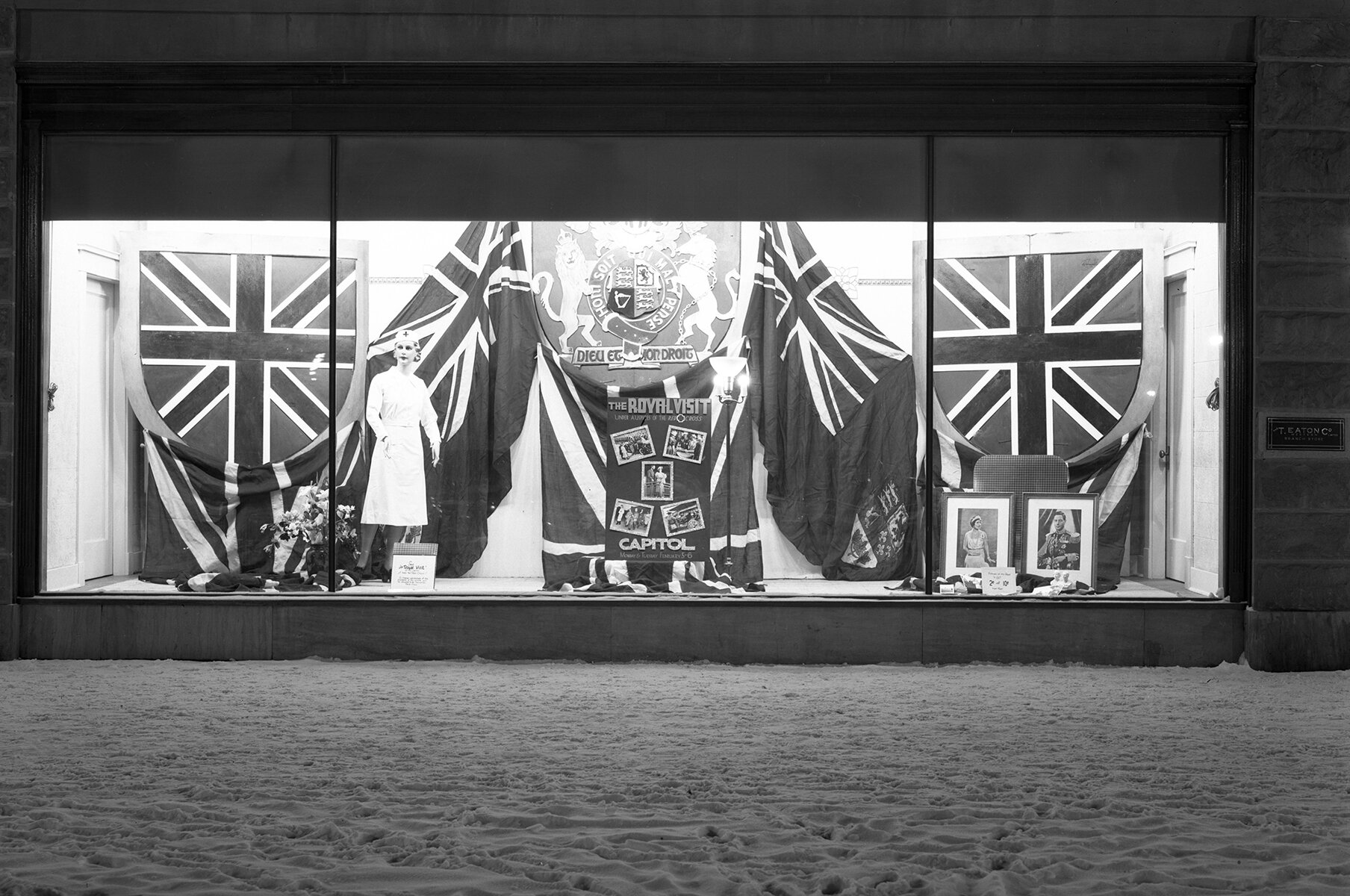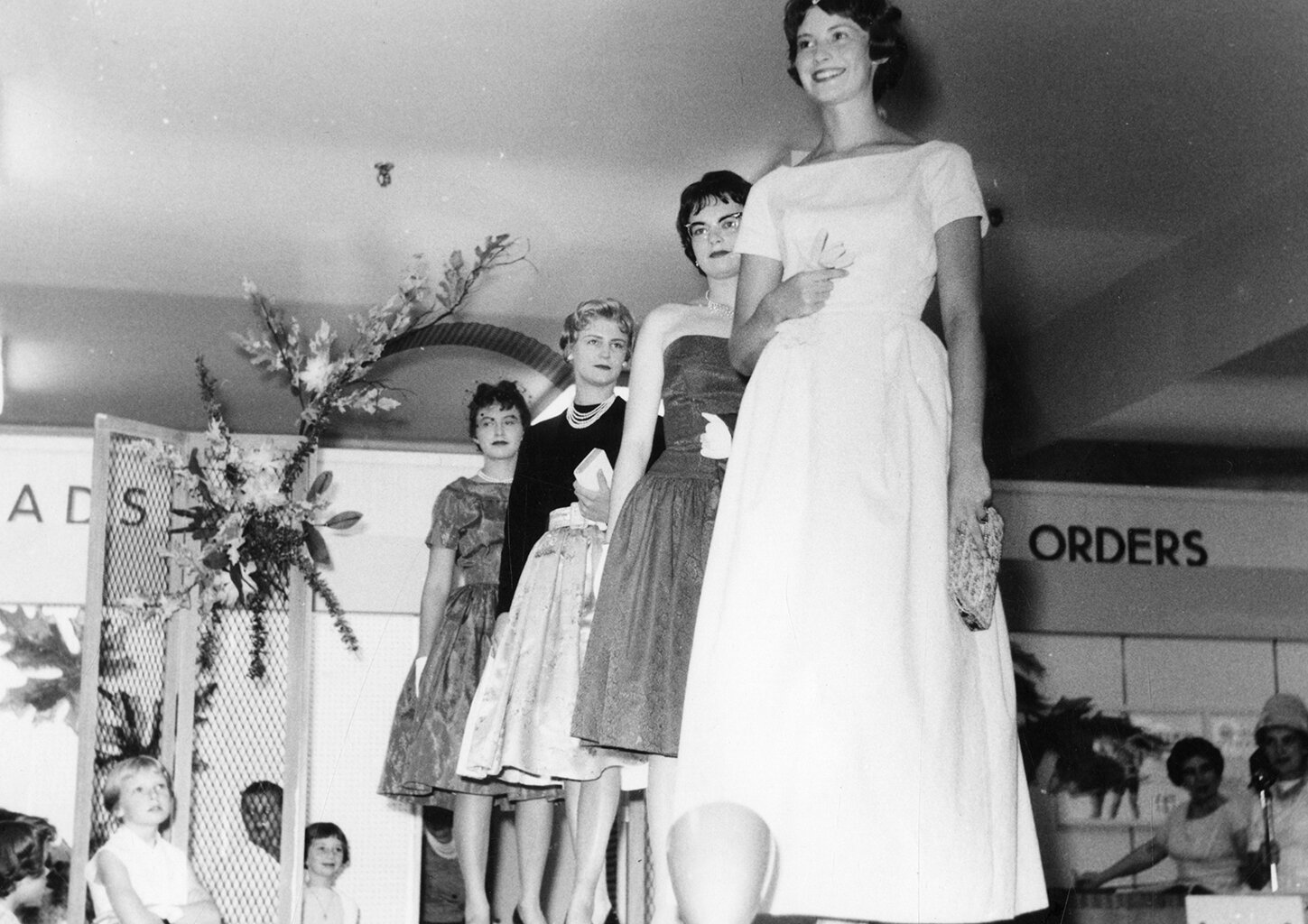curated by Danica Renke, Zoey Lorne and Aimee Benoit
The Rise of the Department Store
Department stores were founded in the mid-1800s and soon spread throughout Europe and North America. They sold everything from bicycles to ginger beer, all inside one building. With novel technology such as escalators, electric lighting and air conditioning, these lavish retail establishments became hubs of activity.
In Canada the industry was defined by three names: the Hudson’s Bay Company, Simpson’s and Eaton’s—once Canada’s largest department store. The T. Eaton Company was founded in 1869 when Timothy and Margaret Eaton purchased a small dry-goods store in Toronto. As the store grew, Eaton’s popularized several retail innovations such as cash-only sales and fixed prices instead of haggling, which was the previous norm.
By 1896 Eaton’s was calling itself “Canada’s Greatest Store.” It became a retail and social institution in Canada with stores across the country, buying offices around the globe, 70,000 employees, and a mail-order catalogue selling everything from clothing to farming implements.
Exterior of Eaton’s Lethbridge on 4 Avenue S, ca. 1950.
Galt Museum & Archives, 19730232005.
Eaton’s Lethbridge
“Eaton’s to Lethbridge and Southern Alberta is like Macy’s to New York.”
— Lethbridge Herald, September 22, 1955
With a booming catalogue business, Eaton’s was in no rush to install brick and mortar stores in western Canada during the early years of the twentieth century. Eventually, the company did see enough demand, however, and in 1926 they opened a series of small self-serve grocery stores across the region.
Eaton’s opened its first “TECO” store in Lethbridge in 1927 at the corner of 4 Avenue and 6 Street South. The store became so successful that in 1955 the company built a new, modern building at the same location. Eaton’s became a landmark in Lethbridge and the main shopping hub for residents looking for quality goods.
When Eaton’s moved into the new Park Place Mall in 1988, a Lethbridge Herald article notified the public that “Eaton’s will no longer have its traditional window displays that have raised excitement as well as some eyebrows over the years.” The store took the opportunity to develop a new image focused on men’s and women’s fashion. However, the move to the mall marked the beginning of Eaton’s decline in Lethbridge, and across the country.
Stuffed bear, Punkinhead, ca. 1957.
Donated by Marg Oberg. Galt Museum & Archives, P20180021001.
Eaton’s launched the Punkinhead teddy bear for the Christmas 1948 season. Marg Oberg received a series of bears from her grandparents when she was a child. She recalled:
“Eaton’s was a very prominent department store in Lethbridge at that point in time, and most everybody did their Christmas shopping at Eaton’s.”
The largest of Oberg’s four Punkinhead bears, this one was also the “most loved.”
Community Involvement
Department stores played an important role in shaping the urban environment in Canada. By the 1950s most small towns had a department store, or access to a wide range of products in catalogues. But Eaton’s offered more than just shopping; the company also played a visible role in the community—most notably through its iconic Santa Claus Parade in Toronto from 1905 to 1981.
In Lethbridge, the Eaton Social and Athletic Club held frequent events involving community members, such as whist drives, card parties and dances. The club sponsored curling competitions and had its own mixed curling team comprised of staff members and their partners. As another form of community participation, specialists from Eaton’s gave talks at the Southern Alberta Teacher’s Convention in order to educate teachers about fabrics in their home economics classes.
These activities no doubt helped capture new customers, but they also earned Eaton’s a special place in Canadians’ hearts.
Individuals looking through Eaton’s spring/summer catalogue, 1921.
Galt Museum & Archives, 20071018084.
The “Homesteader’s Bible”
The Eaton’s catalogue is an iconic symbol of twentieth-century consumerism, but it was also a valuable tool for western Canadians. The catalogue was often referred to as the “Homesteader’s Bible,” and was used by rural residents to order goods that had previously only been available in larger central Canadian cities. These included personal and household items such as clothing, furniture or appliances, as well as farm essentials like seed, equipment and live chickens. In 1912, Eaton’s expanded into housing, selling prefabricated houses that were shipped unassembled by train for $890.
Demand for catalogue items was so great that, by 1910, the Eaton’s catalogue business ran as a separate entity from the Eaton’s store. In 1916 it adopted the “goods satisfactory or money refunded” policy and required that salespeople and ads “must be accurate and honest at all times when describing merchandise.” The Eaton’s catalogue remained trusted and widely used until its final issue in 1976. By that time urbanization and greater access to local Eaton’s stores had made catalogue shopping less popular.
Employee assisting customer with Eaton’s catalogue order, date unknown.
Galt Museum & Archives, 19991091035.
Shoppers at Eaton’s annual $1.49 day sale, ca. 1955.
Galt Museum & Archives, 20191083299.
Women’s Space
Department stores initially focussed on clothing and jewellery to attract more affluent middle-class women. By the early twentieth century, most department stores had elegant tea rooms complete with high ceilings, beautiful views, entirely homemade food and weekly fashion shows. Although these strategies reinforced dominant norms about women’s tastes and needs, department stores also offered a place where women could be independent, away from their homes and families.
Conveniently located next to the bus terminal, Lethbridge Eaton’s was a destination for women to enjoy the afternoon. The store had a soda bar where shoppers could rest and enjoy something to eat, and offered the latest fashions, cosmetics and everything a household could need.
The store was also an important employer for women in Lethbridge and many worked long careers as “Eatonians.”
That was a career for them, and Eaton’s paid well. When you look back, they did have very good jobs… And I guess that was one place where women could be in a management role.
— Kelly Clampitt, former Eaton’s employee
In-store fashion show, ca. 1955.
Galt Museum & Archives, 20191083292.
Millinery and dress department on second floor of Eaton’s store, 4 Avenue and 6 Street S, ca. 1950–1960.
Galt Museum & Archives, 19991091031.
End of an Era
In the later twentieth century, traditional department stores faced growing competition from shopping malls, discount retailers and online shopping. The Hudson’s Bay Company, Sears Canada and Zellers all took market share from Eaton’s, and the creation of big-box stores in the 1990s made it difficult to compete.
The changing economic and retail environment, as well as mismanagement from the last two generations of Eaton’s family members, led to Eaton’s demise. While the T. Eaton Company had controlled 60 percent of department store sales in Canada in 1930, this was reduced to just 11 percent in 1997. Eaton’s declared bankruptcy and closed in 1999 after 130 years as a Canadian retail empire.
























For many decades, the T. Eaton Company (later just “Eaton’s”) was a major catalogue supplier.